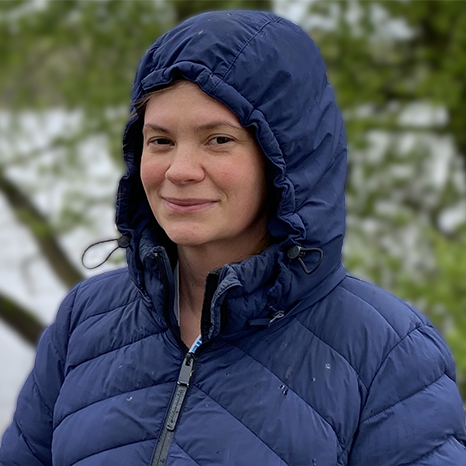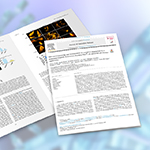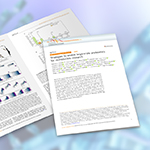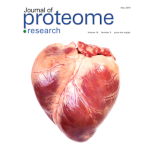Collection of our favorite papers
If you're anything like us, you have a stack of publications by fellow scientists that you are eager to read.
We thought this felt a little bit like wanting to read a new book, but walking into the bookstore and feeling overwhelmed by all the awesome potential! Like us, I am sure you’re drawn to the employee recommendations, because at least someone you “know” read it and can give it a little more color than the book jacket does. Because of that, we have collected some of our favorite papers, and our colleagues are here to tell you why!
Rebekah Sayers
EMEAI Applications Lead, Life Science Research/OMICS – SCIEX

Rebekah Sayers
EMEAI Applications Lead, Life Science Research/OMICS – SCIEX
"Recently, the use of biomaterials to deliver neural stem cells (NSCs) during stem cell therapy to treat brain and spinal cord injuries has shown real promise for helping to avoid cell death. But traditional techniques for assessing the safety of stem cell nanoengineering fall short when it comes to providing insights into the subtleties of cellular physiology or regenerative capabilities. This paper is interesting for 2 reasons. First, it describes a novel application of a data-independent MS approach that uses proteomics to confirm there are no undesirable proteome changes caused by the process. And second, it's exciting to see MS technology being used to accelerate the incredibly important area of stem cell research."

Rebekah’s favorite paper
Safe nanoengineering and incorporation of transplant populations in a neurosurgical grade biomaterial, DuraGen Plus, for protected cell therapy applications
Jérémy Potriquet
Field Application and Market Development Specialist – SCIEX

Jérémy Potriquet
Field Application and Market Development Specialist – SCIEX
"I particularly love how this paper provides further evidence of the incredible reproducibility that mass spectrometry proteomics is able to achieve, even over an extended period of time and with large sample cohorts. This study not only provides evidence that modern quantitative proteomics is very reproducible in concordance with previously attempted large-scale qualitative comparisons, but also demonstrates the importance of data normalization when dealing with large batches of samples. This is particularly relevant for the ever-growing demand in highthroughput proteomics that is paving the way for clinical applications."

Jérémy’s favorite paper
Strategies to enable large-scale proteomics for reproducible research
Mark Cafazzo
Senior Director of Innovation – SCIEX

Mark Cafazzo
Senior Director of Innovation – SCIEX
"Unfortunately, everyone knows someone touched by Alzheimer’s or rheumatoid arthritis. Listening to Justyna’s talk about this work at the SCIEX ASMS user meeting, I really appreciated the clever way they harnessed biology to solve the challenging analytical problems around studying citrullinated proteins, and hopefully address diseases such as rheumatoid arthritis and Alzheimer’s."

Mark's favorite paper
Mapping citrullinated sites in multiple organs of mice using hypercitrullinated library
Arianna Jones
Global Strategic Marketing Manager,
Life Science Research – SCIEX

Arianna Jones
Global Strategic Marketing Manager, Life Science Research – SCIEX
"Anyone who’s ever studied post-translational modifications knows just how tricky they are to analyze using LC-MS! They’re hugely important for biomedical research, and yet it’s so tough to get enough sample. To study these essential functional proteins, it is critical to develop more efficient and flexible ways to analyze single and multiple PTMs in one go. This paper describes a unique “one-pot” workflow that, when combined with SWATH acquisition, offers comprehensive and quantitative results, giving researchers the ability to delve into simultaneous acetyl- and succinyl-lysine enrichment (and could be extensible to others!), and cuts the time for sample prep and MS data acquisition in half."

Arianna's favorite paper
Simultaneous quantification of the acetylome and succinylome by 'one-pot' affinity enrichment
Tom Knapman
Sr Manager, Strategic Marketing,
Brand and Creative – SCIEX

Tom Knapman
Sr Manager, Strategic Marketing, Brand and Creative – SCIEX
“If, like me, you’re one of those people who can’t stand the thought of someone touching your eye, the implications in this paper will really resonate. nAMD is a condition where abnormal blood vessel growth causes sight degeneration and ultimately blindness in elderly people. Currently the standard treatment is administration of anti-VEGF via a direct injection into the white of the eye. Ugh! As if that wasn’t bad enough, treatment is effective in only around 50% of cases, so there is a real need for markers to determine who will actually respond to the treatment. This paper describes a precision medicine approach using untargeted metabolomics to quantify serum metabolic signatures and predict response to anti-VEGF therapy.”

Tom's favorite paper
A serum metabolomics study of patients with nAMD in response to anti-VEGF therapy
Melanie Juba
Senior Manager, Biopharma Accurate Mass – SCIEX

Melanie Juba
Senior Manager, Biopharma Accurate Mass – SCIEX
"Within the first paragraph of this paper I was drawn in! What initially grabbed my attention was the devastating facts about heart failure and the challenges of diagnosis. The findings presented in the paper are much needed as we think about the possibility of identifying better predictors and new biomarkers of heart failure moving forward."

Melanie's favorite paper
Metabolic modulation predicts heart failure tests performance
These are open access articles under the terms of the Creative Commons Attribution License, which permits use, distribution and reproduction in any medium, provided the original work is properly cited.